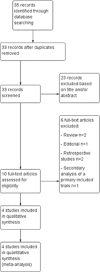Loop Electrosurgical Excision Procedure versus Cryotherapy in the Treatment of Cervical Intraepithelial Neoplasia: A Systematic Review and Meta-Analysis of Randomized Controlled Trials
- PMID: 30306032
- PMCID: PMC6172872
- DOI: 10.4103/GMIT.GMIT_56_18
Loop Electrosurgical Excision Procedure versus Cryotherapy in the Treatment of Cervical Intraepithelial Neoplasia: A Systematic Review and Meta-Analysis of Randomized Controlled Trials
Abstract
Aim: Invasive cervical cancer is proceeded by a phase of preinvasive disease that is slow to progress and can be detected, treated, and collectively referred to as cervical intraepithelial neoplasia (CIN). Several excisional and ablative treatments for CIN have been studied, with loop electrosurgical excision procedure (LEEP) and cryotherapy being the two most commonly utilized. The objective of this systematic review and meta-analysis of randomized controlled trials (RCTs) was to compare the compare harms and benefits of LEEP versus cryotherapy in women with CIN.
Methods: Electronic databases were searched from their inception until May 2018. We included all RCTs comparing cryotherapy versus LEEP in women with CIN. We included trials evaluating both HIV-seropositive and HIV-seronegative women. The primary outcome was the persistence of the disease at 6-month follow-up. Meta-analysis was performed using the random-effects model to produce summary treatment effects in terms of relative risk (RR) with 95% confidence interval (CI).
Results: Four trials, including 1035 women with CIN, were identified as relevant and included in the meta-analysis. Women who received LEEP for CIN had a significantly lower persistence at 6-month follow-up biopsy (RR: 0.87, 95% CI: 0.76-0.99) and significantly lower recurrence at 12-month follow-up biopsy (RR: 0.91, 95% CI: 0.84-0.99) compared to those who received cryotherapy. No between-group differences were found in the complications rate, but the analyses were not powered for these outcomes.
Conclusions: In women with CIN, treatment with LEEP was associated with a significantly lower risk of persistence disease at 6 months and recurrence disease at 12 months compared to treatment with cryotherapy.
Keywords: Cervical cancer; Pap test; cervical intraepithelial neoplasia; colposcopy; gynecology.
Conflict of interest statement
There are no conflicts of interest.
Figures



References
-
- Parkin DM. Cancer in developing countries. Cancer Surv. 1994;19-20:519–61. - PubMed
-
- McCredie MR, Sharples KJ, Paul C, Baranyai J, Medley G, Jones RW, et al. Natural history of cervical neoplasia and risk of invasive cancer in women with cervical intraepithelial neoplasia 3: A retrospective cohort study. Lancet Oncol. 2008;9:425–34. - PubMed
-
- Jones HH. Treatment of cervical intraepithelial neoplasia. Clin Obstet Gynecol. 1990;33:826–36. - PubMed
-
- De Vuyst H, Lillo F, Broutet N, Smith JS. HIV, human papillomavirus, and cervical neoplasia and cancer in the era of highly active antiretroviral therapy. Eur J Cancer Prev. 2008;17:545–54. - PubMed
Publication types
LinkOut - more resources
Full Text Sources
Research Materials

